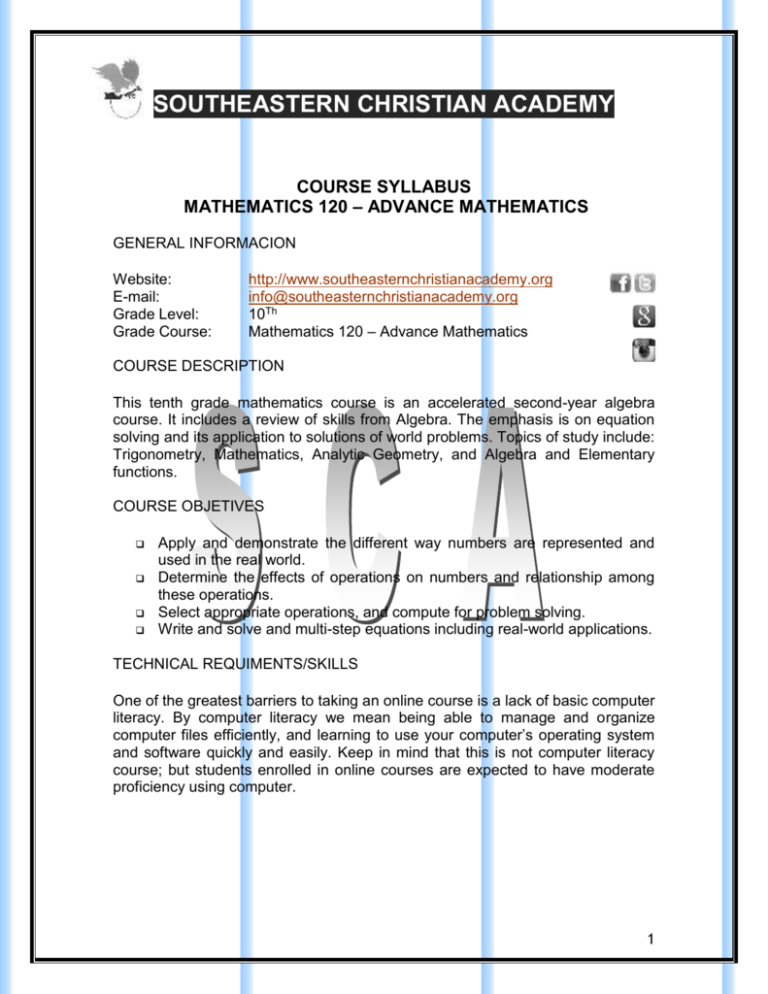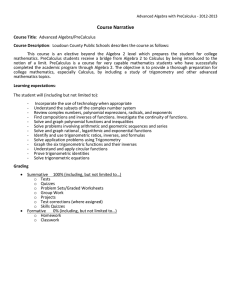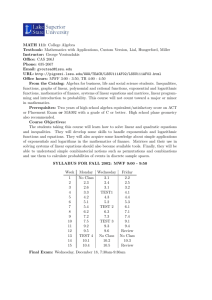SOUTHEASTERN_-_MATH_120 - southeastern christian academy
advertisement

SOUTHEASTERN CHRISTIAN ACADEMY COURSE SYLLABUS MATHEMATICS 120 – ADVANCE MATHEMATICS GENERAL INFORMACION Website: E-mail: Grade Level: Grade Course: http://www.southeasternchristianacademy.org info@southeasternchristianacademy.org 10Th Mathematics 120 – Advance Mathematics COURSE DESCRIPTION This tenth grade mathematics course is an accelerated second-year algebra course. It includes a review of skills from Algebra. The emphasis is on equation solving and its application to solutions of world problems. Topics of study include: Trigonometry, Mathematics, Analytic Geometry, and Algebra and Elementary functions. COURSE OBJETIVES Apply and demonstrate the different way numbers are represented and used in the real world. Determine the effects of operations on numbers and relationship among these operations. Select appropriate operations, and compute for problem solving. Write and solve and multi-step equations including real-world applications. TECHNICAL REQUIMENTS/SKILLS One of the greatest barriers to taking an online course is a lack of basic computer literacy. By computer literacy we mean being able to manage and organize computer files efficiently, and learning to use your computer’s operating system and software quickly and easily. Keep in mind that this is not computer literacy course; but students enrolled in online courses are expected to have moderate proficiency using computer. 1 TEXTBOOK Title: Author: Edition: ISBN: Subject: Merril Advanced Mathematical Concepts: Precalculus with Applications McGraw-Hill/Glencoe for McGraw-Hill Companies 4st edition 13-978-0028243146 │ISBN-10:0028243145 Mathematics INSTRUCTIONAL MATERIALS AND REFERENCES I. Book Reference: Advance Mathematical concepts: Precalculus with Applications, Student Edition by McGraw-Hill Education Advanced Mathematical Concepts Solutions Manual by Merril. Study guide for Advanced Mathematical Concepts: Precalculus with Applications by McGraw-hill. Advanced Mathematical Concepts – Student Woks CD-Rom. Advanced Mathematical Concepts / Pre-calculus with Applications. An online copy is also available. II. Web Reference: http://www.coursemarth.com ttp://www.mathreference.com http://www.classzone.com http://www.math.com http://wwwopenlibrary.com http://www.sosmath.com http://www.algebra.com GRADING & EVALUATION POLICY COURSE REQUIMENTS Quizzes Student Home Page Discussion/Participation Assignments Exam (Online) Final Exam (Online) Research Paper TOTAL WEIGHT 40% 2% 10% 15% 1% 2% 18% 100% 2 A B C D F 100-90 89-80 79-70 69-60 59 & below Topical Outline Chapter 1 Chapter 2 Chapter 3 Chapter 4 Chapter 5 Chapter 6 Chapter 7 Chapter 8 Chapter 9 Chapter 10 Chapter 11 Chapter 12 Chapter 13 Chapter 14 Chapter 15 ACADEMIC MISCONDUCT: Linear Relations and Functions Systems of Linear Equations and Inequalities. The Nature og Graphs Polynomial and Rational Functions The Trigonometric Functions Graphs of Trigonometric Functions Trigonometric Identities and Equations Vectors and Parametric Equations Polar coordinates and Complex Numbers. Conics Exponential and Logarithmic Functions Sequences and series Combinatory and Probability Statistics and Data Analysis Introduction to Calculus Academic misconduct includes cheating (using unauthorized materials, information, or study aids in any academic exercise), plagiarism, falsification of records, unauthorized possession of examinations, intimidation, and any and al other actions that may improperly affect the evaluation of a student’s academic performance or achievement, or assisting others in any such act or attempts to engage in such acts. Academic misconduct in any form is inimical to the purposes and functions of the school and therefore is unacceptable and prohibited. Any faculty member, administrator or staff members may identify an act of academic misconduct and should report that act to the department head or administrative supervisor. Students violating the standards of academic honesty are subject to disciplinary action including reduction of a grade(s) in a specific course, assignment, paper, or project; a formal or informal reprimand at the professorial, dean, or academic vice president level; expulsion from the class in which the violation occurred; expulsion from a program; or expulsion from the school. 3







